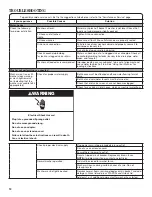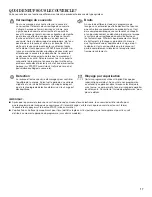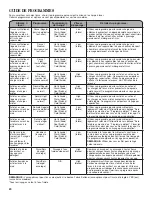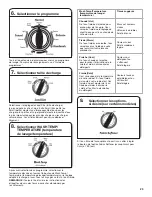
13
TROUBLESHOOTING
If you experience
Possible Causes
Solution
Washer not performing as expected (cont.)
Washer not draining/
spinning, loads are
still wet or spin light
remains on (indicating
that the washer was
unable to pump
out water within
10 minutes)
Small items may have been caught
in pump or between basket and tub,
which can slow draining.
Empty pockets and use garment bags for small items.
Use a cycle with a low
spin speed.
Cycles with lower spin speeds remove less water than cycles
with high spin speeds. Use the recommended cycle/speed spin
for your garment. To remove extra water in the load, select Drain/
Spin. Load may need to be rearranged to allow even distribution
of the load in the basket.
The washer may be tightly
packed or unbalanced.
Tightly packed or unbalanced loads may not allow the washer to
spin correctly, leaving the load wetter than normal. Evenly arrange
the wet load for balanced spinning. Select the Drain/Spin cycle to
remove excess water. See “Using Your Washer”
for loading recommendations.
Check plumbing for correct
drain hose installation. Drain hose
extends into standpipe farther than
4.5" (114 mm).
Check drain hose for proper installation. Use drain hose form
and securely attach to drainpipe or tub. Do not tape over drain
opening. Lower drain hose if the end is higher than 96" (2.4 m)
above the floor. Remove any clogs from drain hose.
Too much detergent causing suds to
slow or stop draining and spinning.
Always measure and follow detergent directions for your load.
To remove extra suds, select Rinse/Spin. Do not add detergent.
Dry spots on load after
cycle
High speed spins extract more
moisture than traditional top-load
washers.
The high spin speeds combined with air flow during the final spin
can cause items near the top of the load to develop dry spots
during the final spin. This is normal.
Incorrect or wrong
wash or rinse
temperatures
Check for proper water supply.
Make sure hot and cold inlet hoses are not reversed.
Both hoses must be attached to both washer and faucet, and
have both hot and cold water flowing to inlet valve.
Check that inlet valve screens are not clogged.
Remove any kinks in hoses.
Energy saving controlled
wash temperatures.
This washer uses cooler wash and rinse water temperatures than
your previous washer. This includes cooler hot and warm washes.
Load not rinsed
Check for proper water supply.
Make sure hot and cold inlet hoses are not reversed.
Both hoses must be attached and have water flowing to the inlet
valve.
Both hot and cold water faucets must be on.
Inlet valve screens on washer may be clogged.
Remove any kinks in the inlet hose.
Using too much detergent.
The suds from too much detergent can keep washer from
operating correctly. Always measure detergent and follow
detergent directions based on load size and soil level.
Washer not loaded
as recommended.
The washer is less efficient at rinsing when load is tightly packed.
Load garments in loose heaps evenly around the basket wall.
Load with dry items only.
Use cycle designed for the fabrics being washed.
Add only 1 or 2 additional garments after washer has started.
Using too low a Load Size selection.
Choose a Load Size that matches the load being washed.
Sand, pet hair, lint, etc.
on load after washing
Heavy sand, pet hair, lint, and
detergent or bleach residues may
require additional rinsing.
Select the Rinse/Spin cycle. Do not add detergent.
Load is tangling
Washer not loaded
as recommended.
See “Using Your Washer” section.
Select a cycle with a slower wash action and spin speed; items
will be wetter than those using a higher speed spin. See the
“Cycle Guide” to match your load with the best cycle.
Load garments in loose heaps evenly around the basket wall.
Reduce tangling by mixing types of load items. Use the
recommended cycle for the type of garments being washed.
To possibly avoid a service call, first try the suggestions listed here or refer to the “Assistance or Service” page.
Содержание W10420470C
Страница 2: ...2 WASHER SAFETY ...
Страница 16: ...16 SÉCURITÉ DE LA LAVEUSE ...














































